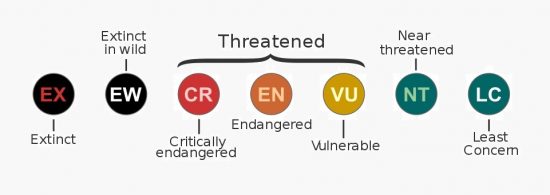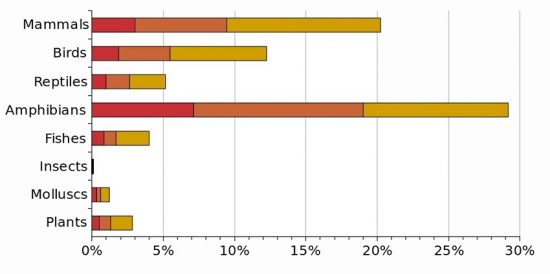Threatened Species Definition
A threatened species is any species which is vulnerable, endangered, or critically endangered. The International Union for Conservation of Nature, or IUCN, is commonly referenced as a leading organization in determining if a species can be considered a threatened species or not.
Threatened Species Overview
The IUCN also defines the category nearly-threatened species, for any animals which are likely to become threatened species within the foreseeable future. The IUCN designation of threatened species can be seen below.
Other organizations may define a threatened species slightly differently. For instance, the United States Endangered Species Act defines a threatened species as any species which is likely to become endangered within the foreseeable future. However, most international organizations and conservation societies tend to use the definition from the IUCN. The difference is only subtle, and either way, a threatened species is one which is likely to go extinct if nothing is done to protect it.
A number of actions can be completed to help a threatened species get off of the list. Conservation efforts are key, such as providing suitable habitat and stopping the illegal harvest of the animals. Beyond this, some critically endangered species have breeding programs established. These programs aim to captively breed organisms, then release them into suitable habitat. Breeding programs have been successful in a number of animals, including the black-footed ferret and giant pandas.
Criteria for a Threatened Species
Population Size Decline
While the criteria for each organization differs, the following are general criteria developed by the IUCN and other organizations to determine if a species can be labeled a threatened species. One of the most important markers of a threatened species is the population size, and its overall direction. A small, decreasing population is much more likely to be threatened than a small, increasing population. Scientists typically measure a population using mark-recapture studies. In these studies, a portion of the population is captured and marked somehow. They are then released. After some time has passed, another portion is captured. Based on the percentage of the recaptured animals which have marks, scientists can estimate the total population. Thus, they can see if the population is very small by capturing the same individuals repeatedly.
Further, the population must be observed over several generations, ideally, to have enough data to truly see a decline in a population. Sometimes, there are not enough animals left for 3 generations, and these species would be a critically endangered threatened species. In larger populations, it is helpful to observe multiple generations to be sure that the population is not simply adjusting to a predator and prey dynamic, or other natural cycles. Some natural cycles can severely affect population numbers, but the general trend in the population can still be increasing. Data which effectively shows that this is not true and that the population is declining generation-over-generation will be more effective in showing that species truly is threatened.
Number of Mature Individuals
Along those lines, scientists must also measure and separate the number of sexually active adults in the population. A sea-turtle, for instance, can lay hundreds of eggs each season. It would be inaccurate, however, to consider all of those offspring as contributing to the next generation. The fact for sea-turtles and many other animals is that many offspring will not make it to sexual maturity. In calculating a threatened species, it is more important to focus on the individuals who have already reached maturity and are actively reproducing.
Due to the limitations of a small genetic pool, the number of reproducing individuals must be relatively high for any population to have a good chance at long term survival. Anything less than 10,000 mature, reproducing adults is usually considered a threatened species, when the other criteria are also met. This is usually based on genetic models. Small populations are typically subject to conditions like genetic drift and population bottlenecks, which can easily drive them to extinction in only a few generations. When a threatened species has less than 250 known mature individuals, it is typically considered critically endangered. Further, if a declining trend is seen in the reproducing adults, this can also be grounds for labeling a threatened species.
Geographic Range
Almost as important as the number of individuals is the geographic range of a threatened species. A species with a cosmopolitan distribution (found globally) is unlikely to be in danger of going extinct. However, if the reproducing adults in that range are actually separated and cannot reproduce, the possibility of extinction increases. This phenomenon is known as habitat fragmentation. It can be natural, such as an impassable mountain range, or man-made, like a highway. Either way, if a species cannot cross the barrier, the populations on each side are effectively on their own.
In terms of designating a threatened species, fragmentation decreases the chances of two adults being able to cross the barrier and divide. Effectively, it creates two smaller populations, each with a lower number of breeding adults. The smaller population size increases the chance of extinction in each group, which raises the total chance of extinction for the species. Thus, fragmentation is an important consideration for threatened species. Generally, animals found in only 1 small area are considered critically endangered. The total size of the area depends on the animal, and the typical range it needs to survive.
As with population size, scientists quantify future and current risks to the geographic range of a species. A threatened species may also be designated in future actions to their habitat put part or all of their population in danger. Deforestation and ocean acidity are two events which are greatly affecting many species right now. The drastic effects will alter their ranges and ultimately their population sizes. Many animals are being added to the threatened species list because of large-scale events like this which affect their range.
Statistical Analysis
To put together a view of the “big picture”, scientist often use computer modeling and simulations to estimate the risk presented to a species. In general, if the chance of the species going extinct over the next 100 years is greater than 10%, the label threatened species can be used. When that threshold begins to reach 50% or greater in the next 10 years, the threatened species is considered critically endangered.
The vaquita, a small porpoise which lives in the Gulf of California, is considered a critically endangered threatened species. There are fewer than 30 individuals left, they are restricted to one location, and they have been declining steadily for decades. This is the kind of devastation that gets an animal to the critically endangered list.
Examples of Threatened Species
Black-footed Ferret
The black-footed ferret (Mustela nigripes) is a threatened species on the verge of extinction. While it is thought that the ferret once had an extended range, poisoning of their prey (prairie dogs) and a plague killed off their population. Further, as the plains became more populated, many prairie dog towns were destroyed, killing off their food source. By the 1960s, the black-footed ferret was extremely rare and limited to a few populations in Wyoming. By 1987, it was considered extinct in the wild.
A massive campaign was undertaken to breed captive black-footed ferrets and reintroduce them to the wild. Since then, the ferrets have been reintroduced to several locations, with varying success. There are now 4 populations of self-sustaining wild ferrets, which greatly increased their chances of getting off the endangered species list. With sustained effort and protections, the ferrets could see a day when they are completely removed from the threatened species list, although that is a far way off.
Tawny Nurse Shark
Found off the coast of Australia and Indonesia, the tawny nurse shark (Nebrius ferrugineus) is a threatened species considered vulnerable by the IUCN. This threatened species has mostly declined, like many sharks, due to fishing practices and harvesting them for their fins. Gill nets and other forms of fishing which are non-selective often catch the sharks and kill them in the process. The sharks are also hunted for their fins, which are part of shark-fin soup, an Asian delicacy which is supposed to have mysterious powers.
This is nonsense, of course, and the harvesting of sharks for their fins has decimated many species. The tawny nurse shark, which reproduces at a low rate and fails to distribute far from where they are born, takes a lot of time to recover. For this reason, it is considered a threatened species, which will need protection in order to succeed in the future.
Other Species
These two species hardly represent all the species on the threatened species list. The IUCN keeps a global list, but every country and even locality may keep their own list or assessment protocol. Further, while these two were vertebrate species, vertebrates represent only a fraction of all threatened species. Below is a graph which breaks down the approximate proportions of species currently on the IUCN Red List.
As you can see, amphibians and other vertebrates do make up a large portion of this list. Also represented are plants, mollusks, and insects. There are even some fungi on the IUCN list (not pictured). There are several reasons for the disparity in the number of species represented from each group. First of all, vertebrates are by far the most studied group, even though their numbers pale in comparison to invertebrates. Secondly, amphibians are currently experiencing the drastic changing effects of climate change and deforestation, which is destroying their habitats and food sources. For this reason, we see a lot of amphibians as threatened species. Plants, mollusks, insects, and other groups with few threatened species are not necessarily doing well, scientists just don’t have enough information to label them as a threatened species.
Quiz


